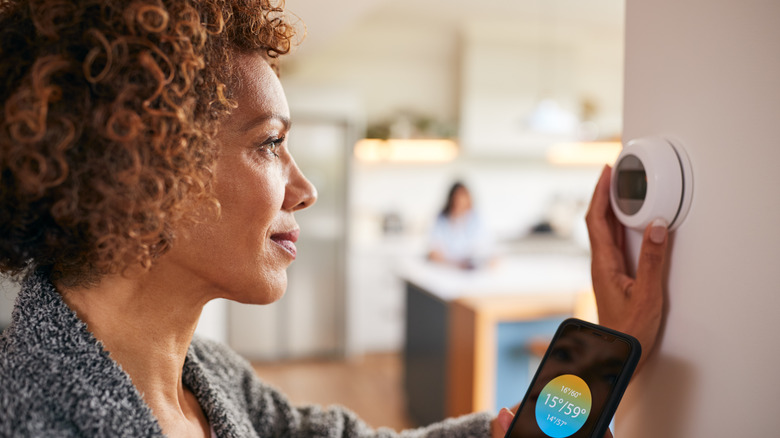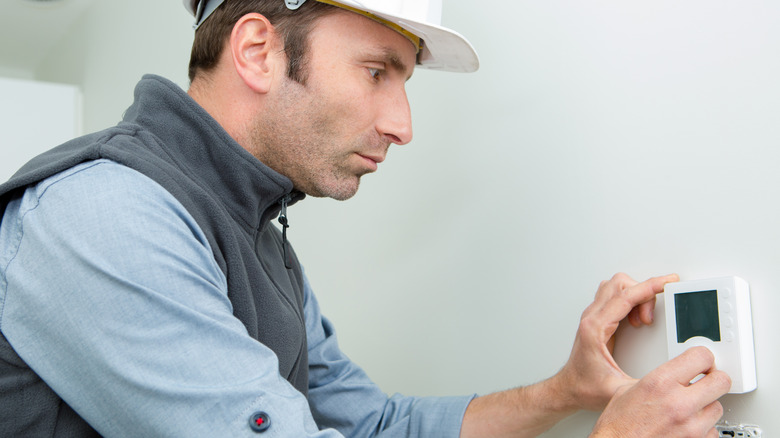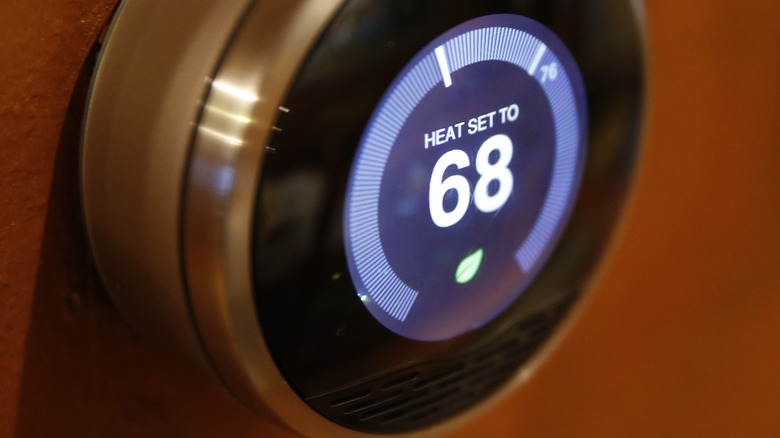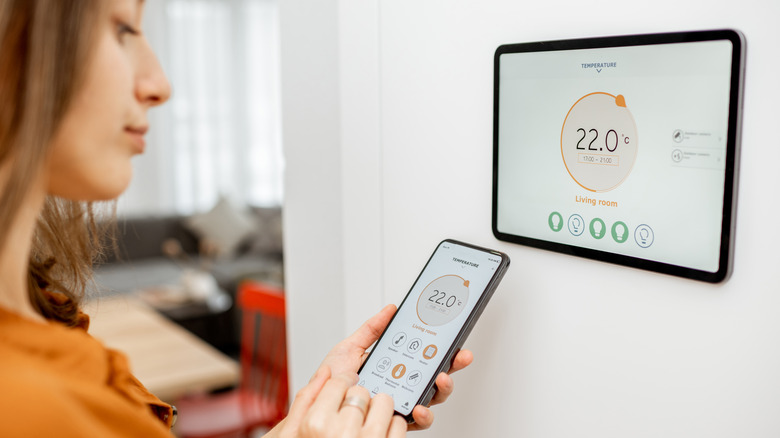5 Things To Consider Before Installing A Smart Thermostat
Making your home smart could mean it's easier to manage from a distance. It may also mean you could benefit from energy-efficiency improvements, depending on the steps you take. If your current thermostat isn't reliable or doing enough for you, consider an upgrade to a smart thermostat. According to Lowe's, a smart thermostat is a device that lets you adjust the temperature and function of it from a smart device, like your smartphone. It may even help to make it possible to track energy consumption and turn your furnace and air conditioner on and off right from bed.
If it sounds fantastic to be able to adjust your thermostat anywhere, even when you're away from home, there are a few things to consider before deciding to install one. The right decision could help ensure you get a device that makes life easier and may even be able to help you save some money.
1. They can help you lower your heating and cooling costs
Not all smart thermostats are equal, but the best of them will automatically adjust your home's heating and cooling to optimal performance levels, according to ENERGY STAR. Further, a smart thermostat will allow you to make adjustments directly from your smartphone, no matter where you're located. If you know you're not going to be home for the day and it's going to be hot outside, you can log into your smart thermostat from an app on your phone and adjust your AC down, potentially saving money, or the system can be programmed to do it for you.
Enabling geofencing on the device allows the thermostat to learn more about what you're doing, such as when you're not home. As a result, it will automatically adjust the temperature in your home to save energy when you're not there or to make it comfortable when you are. You don't have to do anything in the process.
2. They're overall affordable to install
Many smart thermostats can easily be placed right where the existing thermostat for your home is. They come with easy-to-follow directions for setting them up, too. It can become a bit trickier, however, if you need to hire a licensed electrician to handle the installation of a new electrical box. This may be necessary, though, if you are moving the thermostat from where it was to a new location. That's not typically necessary, which means a simple installation could be an option.
Smart thermostats tend to be affordable, too. The national average for installing a smart thermostat is $300, according to Fixr. Higher-end models typically can do more, such as provide touch activation or feature an air quality monitor. These cost a bit more out-of-pocket, averaging around $1,000. Still, for many people, the basic model works just fine. Be sure to spend a few minutes working to determine the best style for your home and your budget.
3. There are several types available
Smart thermostats come in a wide range of styles to fit most needs, but you'll find there are three basic types to consider, according to The Cooling Company. The first is a motion sensor smart thermostat that works to detect proximity and motion in the home to know if someone is in it. If it recognizes a person in the home, it adjusts the settings to make it more comfortable within that space. Geofencing models use a GPS chip and app to create a type of perimeter around the space. After you leave that space, based on your smartphone data, the device adjusts temperatures to an energy-saving mode.
The third type uses algorithms and is more of an advanced model. That means it learns over time and adapts to your scheduling based on how you adjust the thermostat throughout the day and evening. It can update patterns on its own over time, too.
4. Most connect over Wi-Fi
In order to function and provide information to your smartphone, your smart thermostat needs to have a connection. Most do this through Wi-Fi. That means it will link to your home's Wi-Fi signal to send messages over the internet to the app on your phone, no matter if you're in the house or on vacation two states away. This allows you to turn your heating and cooling system on or off, check the current temperature, and gather other data the device provides.
ENERGY STAR states thermostats using Wi-Fi should be close enough to a router within the home. That helps minimize any type of disconnection that occurs should your Wi-Fi connection change. If you have a limited amount of coverage, a Wi-Fi range extender could help improve this range and provide better overall reliability. The thermostat manufacturer will provide information on how to connect your device to your Wi-Fi during installation.
5. There are lots of features to check out
Before buying any smart thermostat for your home, spend some time comparing your options. The good news is you have a lot of features available from numerous manufacturers, according to Berkeley Heating & Air Conditioning. Some will provide indoor air quality control information, allowing you to know if there's a high level of pollutants in your home, excessive moisture, or other concerns. These typically connect to your HVAC's ventilation system to provide that information.
The higher-end models offer zoning systems, which allow you to adjust the temperature based on the area of the home rather than a single set number for the entire space. For example, if you don't use your basement, there's no need to heat it as high as the rest of the home during the winter months. That also means you can adjust the temperature for each bedroom in your home, so everyone's happy, depending on where you set up those zones.





